Tags
alternative cancer treatment, german cancer clinic, Marinus am Stein, prostate cancer, transurethral hyperthermia
Paul had the forethought to take photos of the equipment used during the transurethral hyperthermia treatments so that we could share them with you. Prior to our trip, we had no idea what to expect in terms of the sophistication of the medical technology. (I told Paul later that I was afraid it was going to be a homemade “Rube Goldberg” machine held together with chicken wire and duct tape obtained at the German version of Home Depot.) Thankfully that was not the case.
In our first meeting with Dr. Weber, he showed us a traditional catheter next to the hyperthermia catheter so we could see that they were the same size. He explained how the catheter would be inserted using a numbing gel and how a small inflatable balloon in the bladder would keep it in place.
During the two-hour transurethral hyperthermia treatments, Paul was reclined on the bed with the catheter inserted. There was a rectangular strip of metallic tape applied to his back which completed the circuit between the transmitter and the hyperthermia machine. There is no heating element. The radio waves coming through the catheter cause the prostate to heat to a pre-set temperature which is controlled by the machine (in Paul’s case 122F or 50C). Paul didn’t feel any heating sensation. The only discomfort was from the insertion and removal of the catheter and the burn of the numbing gel.
Just today, we’ve heard from two different men who found us via this blog. Paul just got off of a 1.5 hour call with someone who is heading to Germany in October. We’re really pleased that our little blog is helping others and that we have this opportunity to pay it forward.





Took it like a champ, Paul!
LikeLike
So happy you had s great experience at Mari am Stein Mike is hoping to making another trip. We still stay in contact with the people we met while there. Despite the reason, it is nice to connect with someone who really knows what you are going thru and the emotions you are experiencing too. Sending love to you both and wishes for great results. Keep us posted.
LikeLike
Pingback: First Time Here? Read This First. | Healing and Dealing